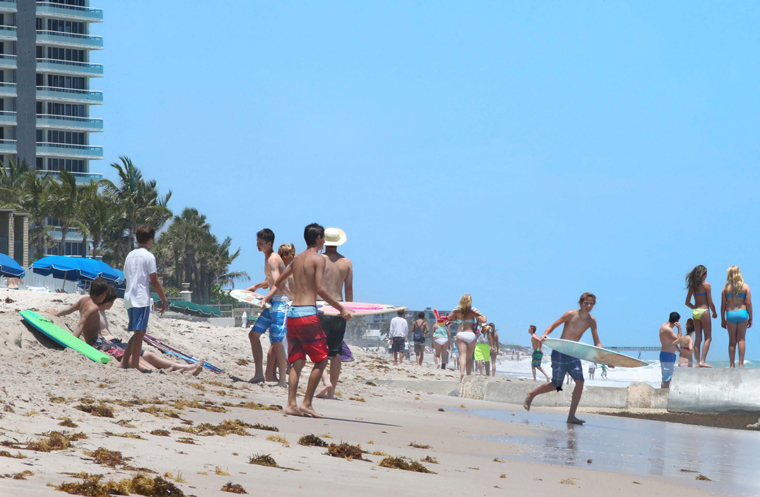
VERO BEACH — The Vero Beach Lifeguard Association, formed in August 2011 by lifeguards and local citizens to promote water safety, continues to have serious safety concerns about the city’s principal draw – its beautiful beaches.
VBLA members point out that despite record-breaking numbers of beachgoers on guarded beaches this past season, the heart of Central Beach, from just north of the Driftwood to the Village Spires, continues to be unguarded.
Under the auspices of the City Recreation Department, lifeguards watch over ocean swimmers at Jaycee, Humiston and South Beach Parks, but Eric Toomsoo, VBLA president, points out that there is no overlapping field of vision along the prime stretch of beach that is home to four hotels.
“That section is mostly tourists, and they don’t know our waters,” says Tim McNamee, a retired Emergency Room physician and VBLA board member, citing rip currents as a constant cause for concern. “That’s why the risk is increased; there’s a lack of local knowledge.
“We need a lifeguard stand at the end of Rte. 60 at Sexton Plaza,” says Dave Farrow of Farrow Construction, and a VBLA board member. “If you have three tires on your car and one is bald, which one are you going to worry about?” asks Farrow.
“We know it’s going to blow; we just don’t know when,” agrees McNamee. “We want to enhance things, not find fault with what has or hasn’t happened.”
Since lifeguards don’t have eyes on the beach in front of the resorts, several have relied on assistance from Scot Caviness, owner of Shark Bait Beach Gear Rentals. Caviness, certified as a lifeguard but not employed as one, leases beach gear to hotel guests and management apparently have his number on speed-dial.
“He’s saved nine people over the last couple of years,” says Toomsoo. “He was at a City Council meeting and a hotel called to tell him there was a guy at the shipwreck in trouble. He drove over from City Hall, got in his kayak and went out and saved him.”
Frigid temperatures and heavy snows brought a resurgence of tourists to the three guarded beaches this year. The VBLA report for March shows attendance at 82,583; by comparison, attendance in March, 2013 was 60,869.
Monthly incident reports include the number of preventive actions taken, minor and medical emergencies, rescues, missing persons and attendance, which includes about 100 yards of beach on either side of the guarded area.
Most rescues have been the result of rip currents, but the two most haunting rescues in the last couple of years were the result of shark bites to German and Peruvian tourists. Both victims were fortunate that they were within eyesight of lifeguards who leapt into action, or the consequences could have been quite different.
In contrast, a man from Hawaii disappeared in the surf last May, and a number of years back, a young teen drowned after purposely leaving a guarded beach because he was told by lifeguards that conditions were “double red,” meaning too dangerous to swim.
“We’ve never had a situation where we’ve actually lost someone during guarded hours,” said Toomsoo.
Farrow remembers back to his lifeguard days in Ocean City, MD, where the safety of families was of such paramount importance that there were 10 miles of protected beaches, whereas in Vero’s 4-mile shoreline, there are only 600 yards of beach guarded by shortened hours.
“We’re called Vero Beach for a reason; our No. 1 asset is a guarded beach,” said Farrow. “I’m volunteering my time because I know what a guarded beach can bring to the city. When you have a protected beach, families go there and the city flourishes.”
McNamee said another issue is that out-of-towners used to swimming up north where there is often greater lifeguard coverage, may assume it is the same here.
“There’s a potential for a real serious problem if people don’t know that the beaches aren’t guarded as they thought,” says McNamee. Citing the early closings, he adds, “I’ve seen lifeguards leave the beach [at the end of the shift] when there’s 200 people on the beach. They don’t go home when the lifeguards leave.”
Of the 14 beach lifeguards, 5 are certified EMTs and 2 are paramedics, and without their lifesaving skills, the shark bite victims would likely not have survived.
Toomsoo would like to see a better avenue of communication developed between emergency 911 dispatchers and lifeguards, especially considering that they are all dealing with limited resources.
“A lot of times when people see a distressed swimmer between the towers they call 911, and the dispatchers call the police or fire rescue,” said Toomsoo. “We’re suggesting dispatch call to see if we see anything out there. We had a medical emergency in the parking lot at South Beach, and we were never called. What we’re suggesting is a better coordination between ocean rescue and other rescue personnel.”
“Part of the problem I view as an outsider, is that swimming is considered a recreation,” says McNamee. “It’s a slight alternation from what a lifeguard’s primary function is; they’re out there for public safety.”
“The VBLA was formed with a goal to promote lifeguarding and water safety; that’s our mission statement,” says Toomsoo. “We can’t change policy; we can only recommend these things.”



